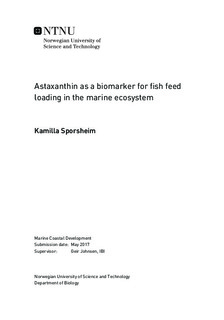Astaxanthin as a biomarker for fish feed loading in the marine ecosystem
Master thesis
Permanent lenke
http://hdl.handle.net/11250/2448128Utgivelsesdato
2017Metadata
Vis full innførselSamlinger
- Institutt for biologi [2616]
Sammendrag
Organic waste released from a fish farm, is one of the main challenges facing aquaculture today, and to increase fish, production it is important to minimize the impact this have on the environment. The aim of this study was to elucidate the carotenoid Astaxanthin as a biological tracer from pen raised Atlantic salmon (Salmo salar) feed causing organic waste to the surrounding ecosystem, as to the author knowledge this is not done before. By using target organisms Blue mussel (Mytilus edulis), Whelk (Buccinum undatum), and seawater, seabed sediments and in situ video survey. In vitro absorbance and HPLC isolation of pigment extracts where the main methods used. The findings show increased Astaxanthin concentration in Atlantic salmon muscle tissue with increased size of fish at performed feeding program. High Astaxanthin content was found in fish feces at poor feed utilization. No abnormal high values of Astaxanthin were observed in water surface, Blue mussel and Whelk food uptake or tissue content. Zooplankton reveals Atlantic salmon s natural source of Astaxanthin. Seabed sediments showed presence of Astaxanthin, but in low concentration (<1.2 µg g-1), which seems to be normal. Quick dilution of organic waste was observed, but also presence of Beggiatoa sp. reveals low oxygen level on the seabed and sedimentation of organic matter. For future research, measure Astaxanthin concentrations at sites with more accumulated organic waste on the seabed to conclude whether if this is a good method for future monitoring programs or not.
